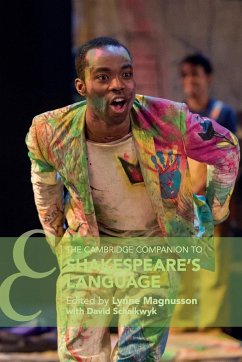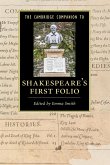The Cambridge Companion to Shakespeare's Language
Herausgeber: Magnusson, Lynne; Schalkwyk, David
27,99 €
inkl. MwSt.
Versandfertig in 1-2 Wochen

14 °P sammeln
The Cambridge Companion to Shakespeare's Language
Herausgeber: Magnusson, Lynne; Schalkwyk, David
- Broschiertes Buch
- Merkliste
- Auf die Merkliste
- Bewerten Bewerten
- Teilen
- Produkt teilen
- Produkterinnerung
- Produkterinnerung
Illuminates the pleasures and challenges of Shakespeare's complex language for today's students, teachers, actors and theatre-goers.
Andere Kunden interessierten sich auch für
![The Cambridge Companion to Shakespeare's Language The Cambridge Companion to Shakespeare's Language]() The Cambridge Companion to Shakespeare's Language75,99 €
The Cambridge Companion to Shakespeare's Language75,99 €![The Cambridge Companion to Shakespeare's First Folio The Cambridge Companion to Shakespeare's First Folio]() The Cambridge Companion to Shakespeare's First Folio28,99 €
The Cambridge Companion to Shakespeare's First Folio28,99 €![The Cambridge Companion to Frankenstein The Cambridge Companion to Frankenstein]() The Cambridge Companion to Frankenstein30,99 €
The Cambridge Companion to Frankenstein30,99 €![The Cambridge Companion to 'Emma' The Cambridge Companion to 'Emma']() The Cambridge Companion to 'Emma'29,99 €
The Cambridge Companion to 'Emma'29,99 €![The Cambridge Companion to Bunyan The Cambridge Companion to Bunyan]() The Cambridge Companion to Bunyan19,99 €
The Cambridge Companion to Bunyan19,99 €![The Cambridge Companion to Science Fiction The Cambridge Companion to Science Fiction]() Edward James / Farah Mendlesohn (eds.)The Cambridge Companion to Science Fiction115,99 €
Edward James / Farah Mendlesohn (eds.)The Cambridge Companion to Science Fiction115,99 €![The Cambridge Companion to British Romanticism The Cambridge Companion to British Romanticism]() The Cambridge Companion to British Romanticism73,99 €
The Cambridge Companion to British Romanticism73,99 €-
-
-
Illuminates the pleasures and challenges of Shakespeare's complex language for today's students, teachers, actors and theatre-goers.
Produktdetails
- Produktdetails
- Verlag: Cambridge University Press
- Seitenzahl: 314
- Erscheinungstermin: 8. August 2019
- Englisch
- Abmessung: 229mm x 152mm x 18mm
- Gewicht: 457g
- ISBN-13: 9781107583184
- ISBN-10: 1107583187
- Artikelnr.: 55295009
- Herstellerkennzeichnung
- Libri GmbH
- Europaallee 1
- 36244 Bad Hersfeld
- gpsr@libri.de
- Verlag: Cambridge University Press
- Seitenzahl: 314
- Erscheinungstermin: 8. August 2019
- Englisch
- Abmessung: 229mm x 152mm x 18mm
- Gewicht: 457g
- ISBN-13: 9781107583184
- ISBN-10: 1107583187
- Artikelnr.: 55295009
- Herstellerkennzeichnung
- Libri GmbH
- Europaallee 1
- 36244 Bad Hersfeld
- gpsr@libri.de
Part I. Basic Elements: 1. Shakespeare and the problem of style Jeff Dolven
2. Shakespeare's creativity with words Alysia Kolentsis
3. The performative power of Shakespeare's language David Schalkwyk
4. Verse and metre Oliver Morgan
5. The dynamics of Shakespearean dialogue Lynne Magnusson
6. Figures of speech at work Ruth Morse
Part II. Shaping Contexts: 7. Approaching Shakespeare through rhetoric Peter Mack
8. Shakespeare and social languages James Siemon
Part III. New Technologies: 9. Digital approaches to Shakespeare's language Jonathan Hope
10. Authorship, computers, and comparative style Hugh Craig
11. Reading in time: cognitive dynamics and the literary experience of Shakespeare Amy Cook and Seth Frey
Part IV. Contemporary Sites for Language Change: 12. Writing for actors: language that cues performance Carol Chillington Rutter
13. Language and translation Dirk Delabastita
14. Popular culture and Shakespeare's language Douglas M. Lanier.
2. Shakespeare's creativity with words Alysia Kolentsis
3. The performative power of Shakespeare's language David Schalkwyk
4. Verse and metre Oliver Morgan
5. The dynamics of Shakespearean dialogue Lynne Magnusson
6. Figures of speech at work Ruth Morse
Part II. Shaping Contexts: 7. Approaching Shakespeare through rhetoric Peter Mack
8. Shakespeare and social languages James Siemon
Part III. New Technologies: 9. Digital approaches to Shakespeare's language Jonathan Hope
10. Authorship, computers, and comparative style Hugh Craig
11. Reading in time: cognitive dynamics and the literary experience of Shakespeare Amy Cook and Seth Frey
Part IV. Contemporary Sites for Language Change: 12. Writing for actors: language that cues performance Carol Chillington Rutter
13. Language and translation Dirk Delabastita
14. Popular culture and Shakespeare's language Douglas M. Lanier.
Part I. Basic Elements: 1. Shakespeare and the problem of style Jeff Dolven
2. Shakespeare's creativity with words Alysia Kolentsis
3. The performative power of Shakespeare's language David Schalkwyk
4. Verse and metre Oliver Morgan
5. The dynamics of Shakespearean dialogue Lynne Magnusson
6. Figures of speech at work Ruth Morse
Part II. Shaping Contexts: 7. Approaching Shakespeare through rhetoric Peter Mack
8. Shakespeare and social languages James Siemon
Part III. New Technologies: 9. Digital approaches to Shakespeare's language Jonathan Hope
10. Authorship, computers, and comparative style Hugh Craig
11. Reading in time: cognitive dynamics and the literary experience of Shakespeare Amy Cook and Seth Frey
Part IV. Contemporary Sites for Language Change: 12. Writing for actors: language that cues performance Carol Chillington Rutter
13. Language and translation Dirk Delabastita
14. Popular culture and Shakespeare's language Douglas M. Lanier.
2. Shakespeare's creativity with words Alysia Kolentsis
3. The performative power of Shakespeare's language David Schalkwyk
4. Verse and metre Oliver Morgan
5. The dynamics of Shakespearean dialogue Lynne Magnusson
6. Figures of speech at work Ruth Morse
Part II. Shaping Contexts: 7. Approaching Shakespeare through rhetoric Peter Mack
8. Shakespeare and social languages James Siemon
Part III. New Technologies: 9. Digital approaches to Shakespeare's language Jonathan Hope
10. Authorship, computers, and comparative style Hugh Craig
11. Reading in time: cognitive dynamics and the literary experience of Shakespeare Amy Cook and Seth Frey
Part IV. Contemporary Sites for Language Change: 12. Writing for actors: language that cues performance Carol Chillington Rutter
13. Language and translation Dirk Delabastita
14. Popular culture and Shakespeare's language Douglas M. Lanier.








